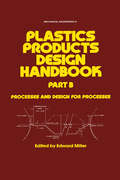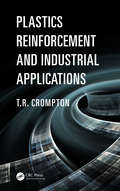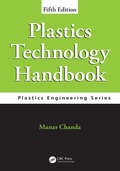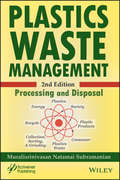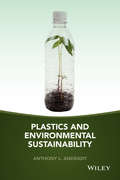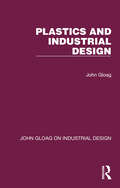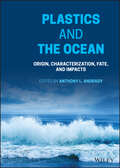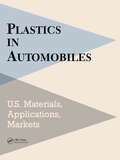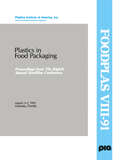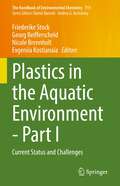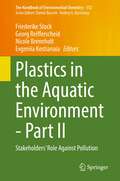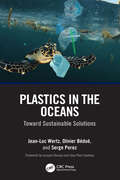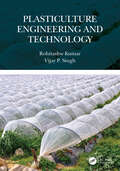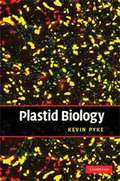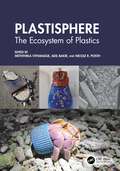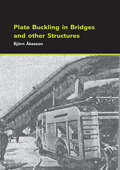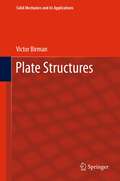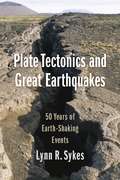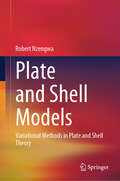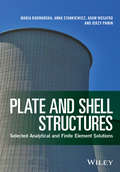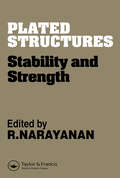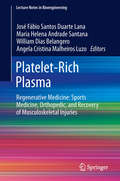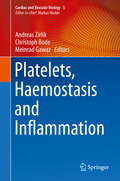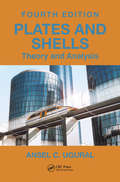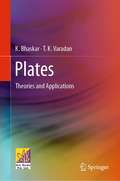- Table View
- List View
Plastics Products Design Handbook
by Edward MillerThis book provides information on complexities, peculiarities, and limitations of various molding processes, and the comparative advantages and disadvantages of the possible plastic products manufacturing techniques, to permit an ideal match of good design and processing.
Plastics Reinforcement and Industrial Applications
by T.R. CromptonWhen combined with reinforcing agents, plastics can be used for a number of high-temperature applications. Plastics Reinforcement and Industrial Applications provides a detailed discussion on plastics, polymers, and reinforcing agents (including organic and natural biomaterials). Focused specifically on improving the mechanical, thermal, and electr
Plastics Technology Handbook (Plastics Engineering)
by Manas ChandaUpdated throughout to reflect advances over the last decade, the Fifth Edition continues the handbook’s tradition of authoritative coverage of fundamentals, production methods, properties, and applications of plastics and polymer-based materials. It covers tooling for plastics fabrication processes, thermoplastics, thermosetting plastics, foamed plastics, reinforced plastics, plastisols, and new developments in mold design. It also discusses rubber compounding and processing technologies. More recent developments in polymer fabrication and processing, including electrospinning, electrografted coating, polymer-metal hybrid joining, flex printing, and rapid prototyping/ 3D printing, are also presented. The handbook highlights advanced materials including natural and synthetic gfnanosize polymers, their unusual properties, and innovative applications, as well as polymer-carbon nanocomposites, graphene-based polymer nanocomposites, smart healable polymer composites, smart polymer coatings, electroactive polymers, polymer nanomaterials, and novel nano-/microfibrillar polymer composites. It offers updates on polymer solar battery development, plastics recycling and disposal methods, new concepts of "upcycling" and single-polymer composites, renewable synthetic polymers, biodegradable plastics and composites, and toxicity of plastics. The book also provides an overview of new developments in polymer applications in various fields including packaging, building and construction, corrosion prevention and control, automotive, aerospace applications, electrical and electronic applications, agriculture and horticulture, domestic appliances and business machines, medical and biomedical applications, marine and offshore applications, and sports.
Plastics Waste Management: Processing and Disposal
by Muralisrinivasan Natamai SubramanianThe book provides clear explanations for newcomers to the subject as well as contemporary details and theory for the experienced user in plastics waste management. It is seldom that a day goes by without another story or photo regarding the problem of plastics waste in the oceans or landfills. While important efforts are being made to clear up the waste, this book looks at the underlying causes and focuses on plastics waste management. Plastics manufacturers have been slow to recognize their environmental impact compared with more directly polluting industries. However, the environmental pressures concerning plastics have forced the industry to examine their own recycling operations and implement plastics waste management. Plastics Waste Management realizes two ideals: That all plastics should be able to persist for as long as plastics are required, and that all plastics are recycled in a uniform manner regardless of the length of time for which it persists. The book examines plastics waste management and systems for the environment, as well the management approaches and techniques which are appropriate for managing the environment. It serves as an excellent and thoughtful plastics waste management handbook. This groundbreaking book: Identifies deficiencies in plastics waste management Extrapolates from experiences to draw some conclusions about plastics waste for persistence Describes methods how the waste related processing techniques should be used in recycling Shows how the consumer and industry can assess the performance of plastics waste management Explains waste utilization by recycling techniques as well as waste reduction Life cycle assessment as an important technique for recycling of persistent plastics waste.
Plastics and Environmental Sustainability
by Anthony L. AndradySurvey's the issues typically raised in discussions of sustainability and plastics Discusses current issues not covered in detail previously such as ocean litter, migration of additives into food products and the recovery of plastics Covers post-consumer fate of plastics on land and in the oceans, highlighting the environmental impacts of disposal methods Details toxicity of plastics, particularly as it applies to human health Presents a clear analysis of the key plastic-related issues including numerous citations of the research base that supports and contradicts the popularly held notions
Plastics and Industrial Design (John Gloag On Industrial Design Ser.)
by John GloagOriginally published in 1945, Plastics and Industrial Design is a non-technical work of reference for manufacturers and designers who, after the Second World War were beginning to realize the possibilities that manufacturing with Plastics could bring. The different types of plastics and their uses is discussed, as is their impact on the design of manufactured articles. Whilst the extensive use of plastic may have fallen out of favour in recent years due to environmental concerns, this book reminds us that in their infancy they offered exciting manufacturing possibilities.
Plastics and the Ocean: Origin, Characterization, Fate, and Impacts
by Anthony L. AndradyAn insightful and multidisciplinary exploration of plastic pollutants in the ocean environment In Plastics and the Ocean, renowned researcher Anthony L. Andrady delivers a comprehensive and up-to-date treatment of the sources, characterization, and environmental impacts of plastics in the ocean. The book focuses on macroplastics as well as micro-scale and nanoscale plastics and the human impacts of these that reach consumers via seafood. It also addresses the human behavioral aspects of the problem via discussions of the mismanagement of urban litter. A diverse collection of expert perspectives is arranged logically and guides the reader through this fast-evolving multi-disciplinary subject area. Beginning with an overview of the field, the book goes on to explore the importance of this area of research to related disciplines and to the everyday lives of consumers. This text offers engineers and scientists an up-to-date review of the subject and the state of the art as summarized by key researchers in the field. The book includes: A synthesis of leading voices in oceanography, biogeochemistry, industrial chemistry, ecotoxicology, polymer science, and behavioral science Discussions of the impacts of a range of marine plastics, including large debris, microplastics, and nanoplastics A summary of the abundance and impacts of plastics in various niches in the marine environment Descriptions of the current methodologies for sampling, detection, processing, and identification of plastic waste Plastics and the Ocean is an indispensable resource for professionals, researchers, instructors, and graduate students in polymer science, marine biology, and environmental engineering. It’s also a must-read text for chemical engineers, materials scientists, and environmental engineers seeking a one-stop resource that describes the origins, occurrence, composition, environmental fate, and biological impacts of plastic pollutants in an ocean environment.
Plastics in Automobiles: U.S. Materials, Applications, and Markets
by Mel SchlechterThis book provides a basic understanding of the major products, technologies, applications, marketing practices and competitive scenario of the plastic automotive business in U.S. It offers current market estimates of the most important polymers broken down by specific automotive application.
Plastics in Food Packaging Conference
by Technomic Publishing Company, Inc.This book contains papers, presented at the eighth annual FoodPlas conference held in Orlando, Florida in 1991, on the role of plastics in supermarkets, food processors and food companies, and on the regulations and design for plastics packaging.
Plastics in the Aquatic Environment - Part I: Current Status and Challenges (The Handbook of Environmental Chemistry #111)
by Georg Reifferscheid Friederike Stock Nicole Brennholt Evgeniia KostianaiaThis book offers a comprehensive review of how plastic pollution is affecting fresh and marine waters, and what the current challenges in plastic waste assessment and management in the aquatic environment are. Plastic waste comprises particles with heterogeneous physicochemical properties such as large size-range, different shapes and polymer types with various additives determining their environmental fate and risk. This complexity raises several open research questions which are explored in this book. Examples are the plastic uptake by aquatic organisms, degradation processes as well as sources and sinks in the environment. Readers will discover real case studies of plastic pollution detection and management in different parts of the world, including Asia, America and Europe, which provide an integrated overview of the global scope of this issue. This book and the companion volume Plastics in the Aquatic Environment - Part II: Stakeholders' Role Against Pollution are valuable resources to students, researchers, policymakers and environmental managers interested in plastic pollution and working towards its reduction.
Plastics in the Aquatic Environment - Part II: Stakeholders' Role Against Pollution (The Handbook of Environmental Chemistry #112)
by Georg Reifferscheid Friederike Stock Nicole Brennholt Evgeniia KostianaiaThis book reviews comprehensively the opportunities and responsibilities of science, society and politics to combat plastic pollution in marine and freshwaters. It provides insights on what information is needed, and from whom, and it outlines policies proposed by various institutions including OSPAR, HELCOM and the European Union. Plastic waste has become a global threat to the aquatic environment that does not stop at country borders. Meanwhile, there are many efforts in science, industry, commerce and governments to tackle the problem worldwide. School education, NGO public actions, voluntary trade reduction measures, governmental management options and governmental regulatory actions are part of the portfolio of efforts to deal with the problem. Together with the companion volume Plastics in the Aquatic Environment - Part I: Current Status and Challenges, it provides scientists, policymakers and environmental managers with essential reference information on how this problem is being solved, what challenges and barriers are expected and how they can be overcome.
Plastics in the Oceans: Toward Sustainable Solutions
by Jean-Luc Wertz Serge Perez Olivier BéduéIncreasing plastic pollution, particularly in oceans, calls for a fundamental shift towards future-proof plastics throughout the circular economy. In a landmark move in 2022, the United Nations adopted a historic resolution to craft an international legally binding instrument to tackle plastic pollution. In line with this global initiative, Plastics in the Oceans investigates the problem of plastic pollution in oceans, proposes solutions relating to current and advanced materials and technologies, and offers an optimal sustainable strategy to eliminate plastic pollution by 2040. The title: Addresses the entire lifecycle of plastic, from production and design to disposal, and advocates for a comprehensive approach to mitigate plastic pollution. Focuses on primary and secondary microplastics, recognizing their significant impact on marine ecosystems. Explores various alternative materials, including biobased biodegradable polymers, as viable alternatives to conventional plastics. Provides insights into regulatory frameworks pertaining to plastic pollution across major world regions. Elucidates the need for reducing plastic production and enhancing recycling efforts in combating plastic pollution. Suggests strategies aligned with the principles of the 3Rs—reduce, redesign, recycle—to foster the development of sustainable and future-proof plastics. This book is aimed at technical readers in environmental engineering, chemical engineering, and polymer chemistry, as well as general readers interested in scientific solutions to the plastics pollution problem.
Plasticulture Engineering and Technology
by Vijay P. Singh Rohitashw KumarThe utilization of successful plasticulture engineering technology can ideally optimize crop yields and provide both economic and environmental benefits, such as reducing the need for water and fertilizer. This book discusses the myriad important aspects of crop production that utilize plastic, such as micro-irrigation, water management, plastic mulch films, protected cultivation and low tunnels, crop covers, canal linings, silage bags, and more. It also examines the latest methods for vertical farming and technological aspects, such as smart agriculture using the internet of things (IoT).The current state of the art, as well as potential future uses,ofplastics isdiscussed in addition to the benefits and limitations of plastics applications in agriculture generally. Features Illustrates application of plastic in protected cultivation, water management, aquaculture, and hi-tech horticulture using innovative technologies to enhance water use efficiency and crop productivity Presents precision farming for climate-resilient technologies Includes real-world examples to present practical insights of plastic engineering for climate change mitigation strategies. Plasticulture Engineering and Technology will serve as a useful resource for students, professionals, and researchers in agriculture and agricultural engineering, hydrology, hydraulics, water resources engineering, irrigation engineering, and environmental science.
Plastid Biology
by Kevin PykePlastids reside in all plant cells, and take on different forms in relation to their cellular function, biochemistry and storage capacity. The modern era of molecular biology and molecular genetics has enabled much to be learnt about how plastids function, and how they relate to their evolutionary past. In this accessible text, Kevin Pyke expertly describes how the plastids are highly complex organelles at the very core of plant cellular function, providing final year undergraduate and graduate students with an overview of plastid biology and recent developments in the field. Topics covered include: a consideration of different plastid types and how they relate to cell function; plastid genomes and how proteins are imported into plastids; photosynthesis and core aspects of plastid biochemistry; plastid signalling and functionality within a cellular context; and plastid genetic manipulation. Supplementary colour images are available online at www.cambridge.org/9780521885010.
Plastisphere: The Ecosystem of Plastics
by Meththika Vithanage Adil Bakir Nicole R. PosthThe plastisphere provides a unique man-made habitat for organisms and microbial communities. Investigating the interactions and functions of these organisms helps us understand how fouling communities can settle on these novel platforms and be moved beyond their natural ranges as well as their contribution to nutrient cycling and biogeochemical processes. This book examines the plastisphere and reveals a secret world of microbes that have adapted to live on plastic surfaces. It explains the ecological effects of plastic pollution, human health concerns, microbial ecology, and mitigation techniques and advocates sustainable solutions. Readers will dive into this enthralling ecosystem rich with microscopic life and explore its mysteries in this thought-provoking book.Features: Presents recent insights into the fundamentals of the plastisphere, with a specific focus on environmental interactions Introduces the work of global experts and their ongoing studies, creative approaches, and new discoveries Highlights the macro and molecular interactions of environmental domains with the plastisphere Explores the notion of bioinvasion that can threaten the health and productivity of our ecosystems Includes detailed multidisciplinary data on the behavior of plastic materials and environmental microbiome Explains the main factors causing ecosystems to evolve and to live in human-made plastic environments Helps readers from various backgrounds to gain a thorough understanding of the topic of the plastisphere This book is an insightful reference for researchers, academics, students, and professionals in Environmental Science, Microbiology, Environmental Engineering, Oceanography, and Material Science.
Plate Buckling in Bridges and Other Structures
by Björn ÅessonA well-illustrated and comprehensive account of various aspects of local buckling in bridges, this book covers the theory and background of buckling, presenting simple design calculations which address this intriguing phenomenon. Attempts to master the process of buckling are described, citing both successes and failures. A number of failure case studies are presented, including five bridge collapses which occurred in a four-year-period between 1969 and 1973. Examining such failures provides valuable information about the phenomenon of buckling. The final section of this book presents easy-to-follow design examples which conform to the latest Eurocode.
Plate Structures
by Victor BirmanPlate structures are used in almost every area of engineering, including aerospace and naval architecture, civil engineering, and electronics. These structures have diverse geometries and have to withstand a wide range of loading conditions. This book provides the theoretical foundations of the theories of plates manufactured from various materials, outlines and illustrates the methods used for the analysis of these structures, and emphasizes designs and solution techniques available to an engineer. The book is written for engineers working in industry, graduate students at aerospace, mechanical, civil engineering and naval architecture departments, and investigators interested in the development of the theory of plates and related subjects. While the mathematical modeling employed in the book is understandable to both engineers and graduate students, the book also provides insight into relevant phenomena and theories underlying plate structures. Thus, the reader is equipped with a thorough understanding of the problems and appropriate assumptions, even if the analysis is conducted using commercially available software codes. In addition, the book includes numerous analytical solutions that can confidently be used in the design of plate structures. The combination of theoretical insight and references to practical problems makes the book equally attractive to academia and industry.
Plate Tectonics and Great Earthquakes: 50 Years of Earth-Shaking Events
by Lynn R. SykesThe theory of plate tectonics transformed earth science. The hypothesis that the earth’s outermost layers consist of mostly rigid plates that move over an inner surface helped describe the growth of new seafloor, confirm continental drift, and explain why earthquakes and volcanoes occur in some places and not others. Lynn R. Sykes played a key role in the birth of plate tectonics, conducting revelatory research on earthquakes. In this book, he gives an invaluable insider’s perspective on the theory’s development and its implications.Sykes combines lucid explanation of how plate tectonics revolutionized geology with unparalleled personal reflections. He entered the field when it was on the cusp of radical discoveries. Studying the distribution and mechanisms of earthquakes, Sykes pioneered the identification of seismic gaps—regions that have not ruptured in great earthquakes for a long time—and methods to estimate the possibility of quake recurrence. He recounts the various phases of his career, including his antinuclear activism, and the stories of colleagues around the world who took part in changing the paradigm. Sykes delves into the controversies over earthquake prediction and their importance, especially in the wake of the giant 2011 Japanese earthquake and the accompanying Fukushima disaster. He highlights geology’s lessons for nuclear safety, explaining why historic earthquake patterns are crucial to understanding the risks to power plants. Plate Tectonics and Great Earthquakes is the story of a scientist witnessing a revolution and playing an essential role in making it.
Plate and Shell Models: Variational Methods in Plate and Shell Theory
by Robert NzengwaThis book presents, in a variational form, very many two dimensional models which have been developed to overcome some weaknesses of the Kirchhoff-Love and Reissner-Mindlin’s models. More precisely the N-T and N models are particularly treated because they clearly show the impact of the change in the third fundamental form whose contribution to the strain energy becomes important when the characteristic ratio of the shell is roughly greater than 0.3. Transverse stresses through-the-thickness are calculated. Gradient Recovery and Strain deformation approach with Curve triangular and Shifted Lagrange elements are implemented. These new FEM appear to be memory less greedy.
Plate and Shell Structures: Selected Analytical and Finite Element Solutions
by Adam Wosatko Anna Stankiewicz Jerzy Pamin Maria RadwańskaPlate and Shell Structures: Selected Analytical and Finite Element Solutions Maria Radwa?ska, Anna Stankiewicz, Adam Wosatko, Jerzy Pamin Cracow University of Technology, Poland Comprehensively covers the fundamental theory and analytical and numerical solutions for different types of plate and shell structures Plate and Shell Structures: Selected Analytical and Finite Element Solutions not only provides the theoretical formulation of fundamental problems of mechanics of plates and shells, but also several examples of analytical and numerical solutions for different types of shell structures. The book contains advanced aspects related to stability analysis and a brief description of modern finite element formulations for plates and shells, including the discussion of mixed/hybrid models and locking phenomena. Key features: 52 example problems solved and illustrated by more than 200 figures, including 30 plots of finite element simulation results. Contents based on many years of research and teaching the mechanics of plates and shells to students of civil engineering and professional engineers. Provides the basis of an intermediate-level course on computational mechanics of shell structures. The book is essential reading for engineering students, university teachers, practitioners and researchers interested in the mechanics of plates and shells, as well as developers testing new simulation software.
Plated Structures: Stability and strength
by R. NarayananFirst published in the 1983. This is third book of a planned set of volumes on the stability and strength of structures. The collapse a few years ago of four large box girders during erection precipitated a considerable research effort in many countries on the various design aspects of plated structures (such as box girders and plate girders). This book is addressed to structural designers and post-graduate students, a fundamental knowledge of structural mechanics is taken for granted; nevertheless, sufficient introductory material is included in each chapter to make the subject matter easily readable. This volume contains eight chapters, all of which are written by persons who have made notable contributions to the relevant subject area. The first four chapters are devoted to various aspects of the design of a plate girder and concentrate largely on the associated stability problems in shear. The four remaining chapters are largely concerned with stability problems in compression, such as those met in box girder flanges and ship hulls. Chapter 8 also highlights some of the complexities of interaction between different stresses. Thus the book covers a wide range of topics of relevance to both the designer and the student.
Platelet-Rich Plasma
by José Fábio Santos Duarte Lana Maria Helena Andrade Santana William Dias Belangero Angela Cristina Malheiros LuzoPlatelet-Rich Plasma (PRP) has gained tremendous popularity in recent years as a treatment option for specialties including Orthopedics, Dentistry, Sports Medicine, Otorhinolaryngology, Neurosurgery, Ophthalmology, Urology, Vascular, Cardiothoracic and Maxillofacial Surgery, and Veterinarian Medicine. Nowadays, PRP and Stem Cell Science have added an exciting dimension to tissue repair. This book begins by giving the reader a broad overview of current progress as well as a discussion of the technical aspects of preparation and therapeutic use of autologous PRP. It is followed by a review of platelet structure, function and major growth factors in PRP (PDGF and TGFβ). The third chapter outlines the basic principles of biochemical cellular metabolism that increases the efficacy of PRP. Analogous to the preparation of soil for a garden, restoring cellular health should be the first consideration in Regenerative Medicine. Standardization of PRP preparation to clinical use still remains a challenging prospect. In this sense, a feasible strategy for studying PRP preparation is illustrated, which also allows to modulate and tailor the quality of PRP for further clinical applications. The science behind PRP and stem cells, on tissue regeneration, cell proliferation and mesenchyme stem-cells are emphasized and reviewed. Various specific uses of PRP are described with detailed illustrations of various personal experiences mainly in orthopedic injuries, ligament and tend on repair, degenerative diseases, sports medicine, chronic wound healing as well as rehabilitation aspects in tendinopathy. Expertly written by leading scientists in the field, this book provides for beginners and experienced readers scientific fundamentals, the state of art of PRP, specific uses and personal experiences with a practical approach and reference for current trends in use. Finally, this book paves the way for future developments.
Platelets, Haemostasis and Inflammation (Cardiac and Vascular Biology #5)
by Andreas Zirlik Christoph Bode Meinrad GawazThe book depicts the various roles of platelets in a variety of cardio-metabolic diseases. Traditional and non-traditional platelet functions are described in detail in atherosclerosis, metabolic syndrome, diabetes, myocardial infarction, and other vascular pathologies. Particular focus is put on platelets as a link between haemostasis and inflammation contributing to both. Last but not least the books links the most recent advances in basic sciences with promising novel therapeutic applications and first results of clinical trials. The book is written for biomedical scientists in the sub disciplines vascular biology, biochemistry and immunology; and it as well will be of interest and value for academic physicians like cardiologists, hematologists, general internists and vascular surgeons.
Plates and Shells: Theory and Analysis, Fourth Edition (Applied and Computational Mechanics)
by Ansel C. UguralNoted for its practical, accessible approach to senior and graduate-level engineering mechanics, Plates and Shells: Theory and Analysis is a long-time bestselling text on the subjects of elasticity and stress analysis. Many new examples and applications are included to review and support key foundational concepts. Advanced methods are discussed and analyzed, accompanied by illustrations. Problems are carefully arranged from the basic to the more challenging level. Computer/numerical approaches (Finite Difference, Finite Element, MATLAB) are introduced, and MATLAB code for selected illustrative problems and a case study is included.
Plates: Theories and Applications
by K. Bhaskar T. K. VaradanThis book covers the essentials of developments in the area of plate structures and presents them so that the readers can obtain a quick understanding and overview of the subject. Several theoretical models are employed for their analysis and design starting from the classical thin plate theory to alternatives obtained by incorporation of appropriate complicating effects or by using fundamentally different assumptions. The book includes pedagogical features like end-of-chapter exercises and worked examples to help students in self-learning. The book is extremely useful for the senior undergraduate and postgraduate students of aerospace engineering and mechanical engineering.
